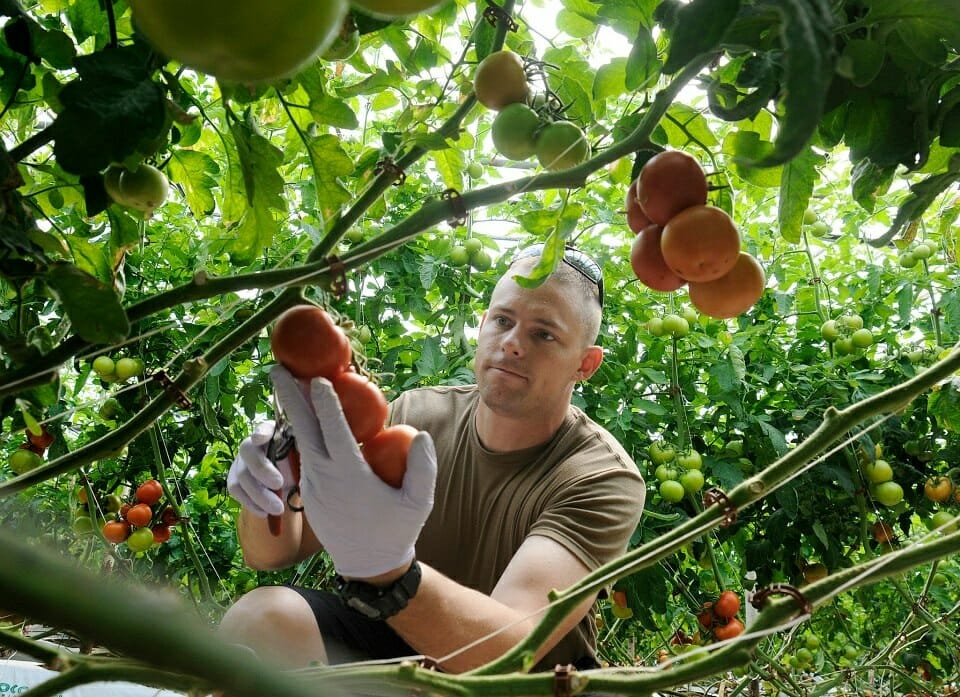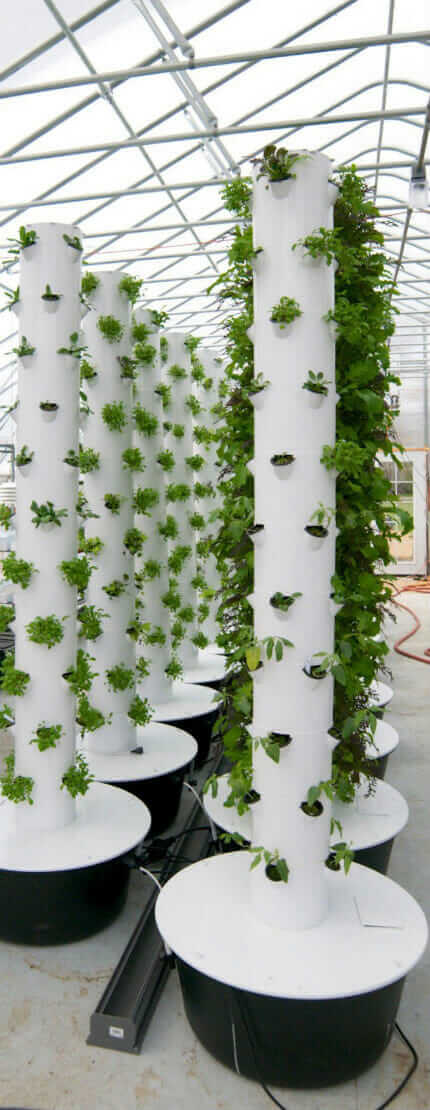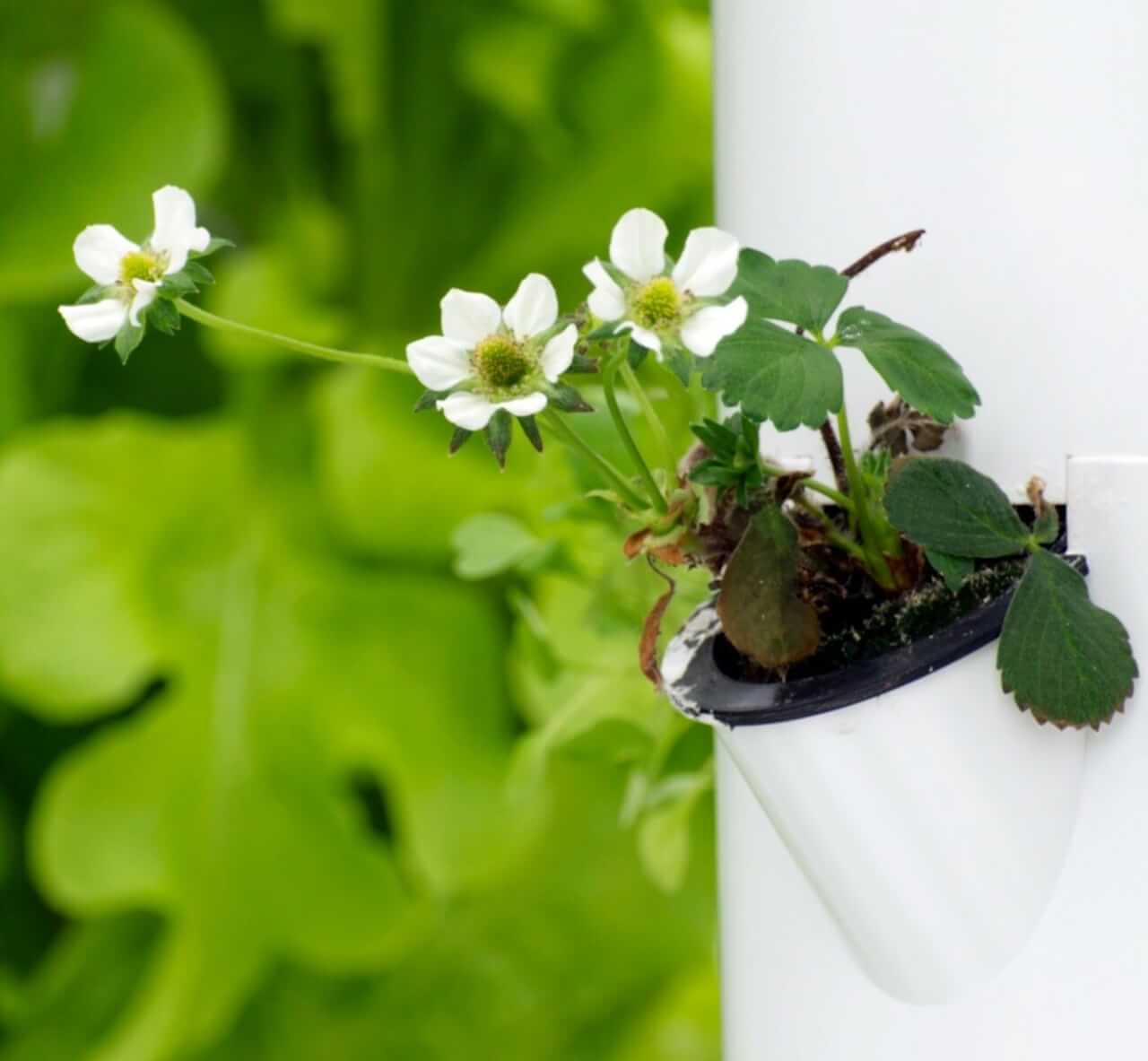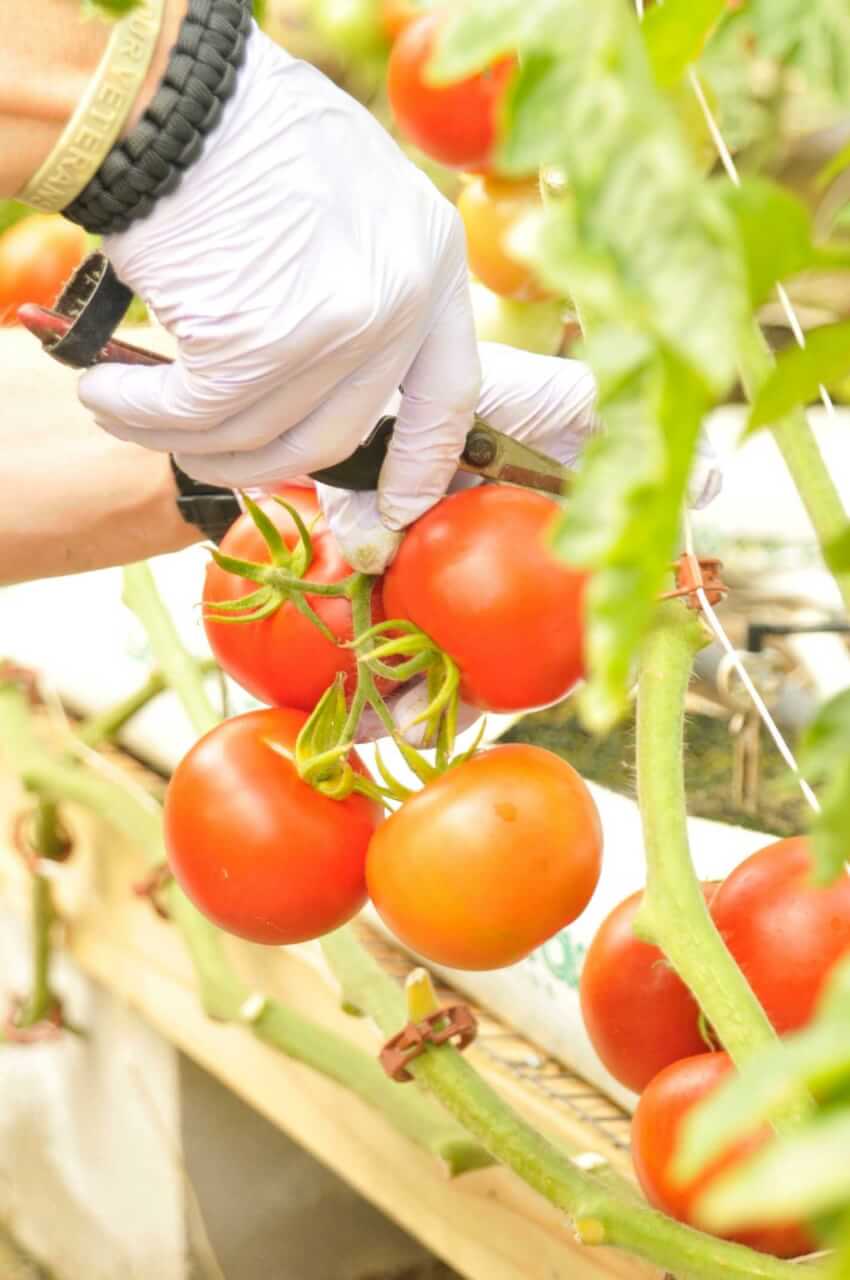Farming a Future for Veterans
The military taught Evan Premer not to waste time fixing a problem. So he’s been quick to start up his own high-tech farm operation in Denver.
Farming a Future for Veterans
The military taught Evan Premer not to waste time fixing a problem. So he’s been quick to start up his own high-tech farm operation in Denver.

If Steve Jobs had added a gardening section to the Apple Store, it might look something like Premer’s farm. Bunches of watercress, arugula, romaine and other greens spill from the sides of 24 sleek, white towers. Streams of nutrient-laced water trickle over the exposed roots inside each tower, giving the plants all they need to grow. There are no raised beds or piles of compost at Aero Farm Co. There isn’t a single grain of soil.
Premer uses aeroponic technology to grow baby lettuce and microgreens for restaurants in the Denver area. He is also working on setting up a community-supported agriculture program (CSA) for the neighborhood around the farm. “It’ll be the first year-round CSA in the state,” he says proudly, explaining that he could control the greenhouse environment throughout the winter.
Premer grew up in Denver, far from an agricultural lifestyle, but after losing a job maintaining rental properties, he got a call from Buck Adams, the founder of an organization called Veterans to Farmers (V2F). Adams offered Premer the chance to join an intensive eight-month program that trained former soldiers in the methods and business of controlled-environment agriculture (CEA), the broad term for technology that creates a growing environment.
After a year of toying with the possibility, looking for odd jobs, and trying for an associate’s degree in photography (all of the photos in this story are his), Premer jumped on board.
For the most part, Premer keeps mum about his military service. “I gunned out of the side of a Blackhawk helicopter,” he says. After a long pause, he added, “That’s all I am willing to say.”
He is much keener to discuss the future, which includes plans to develop a new veteran training facility with Adams in downtown Denver. Premer’s wife, Heather, plans to join him as the Director of Administration as soon as Aero Farm shows a profit, meaning his daughter Alana will visit the greenhouse more often.
“I am so excited to show other veteran families what’s possible,” Premer say. The new breeze ruffled the towers. “This is just the tip of the iceberg.”
From Protector to Provider
Soldiers returning from Iraq and Afghanistan face a daunting transition to civilian life. According to Iraq and Afghanistan Veterans of America, veteran unemployment is three points higher than the national average. Those who can’t work face a nine-month wait for disability benefits. The psychological challenges of the battlefield are even more widespread. Over 50 percent of veterans suffer from Post-Traumatic Stress Disorder (PTSD) upon their return, which can include nightmares, anxiety, flashbacks and depression. About every 80 minutes, a former warrior takes his or her own life. As Buck Adams puts it, these psychological effects can make veterans “a little twitchy” when they first return home to the United States.
Buck believes that part of this twitchiness stems from a feeling that, as a veteran, one lacks a sense of purpose in the civilian workforce. For years, veterans have awoken every morning with a mission and a team. Once home, they might lack both. “Listen, I am not a therapist,” says Adams, “but I’ve seen farming work. My guys fall in love with the growing process, taking it to market, and being thanked for what they’ve done.”
After leaving the service, Adams walked a serpentine path to his current venture with V2F. He tried acting and modeling in California. He twice went under the knife to beat back a brain tumor. He decided to move to Colorado for a fresh start. Initial plans to build a geothermal power plant fizzled out after he discovered the idea was a few hundred million dollars outside of his price range, but as soon as he began talking to people about sustainability, he realized that there wasn’t enough conversation about food and farming.
Adams’ parents farmed chickens on contract for Tyson Farms in Arkansas. He wondered if he could apply that business model to the local food movement. In 2009, Buck started Circle Fresh Farms with John Nichols, a friend from Pueblo who already owned a 12,000 sq. ft. greenhouse. They expanded under the Tyson model, establishing a central production and marketing company to assist a number of independently owned farms. While searching for ideal candidates to run those farms, Buck thought of veterans.
“Veterans are used to environments that require a high level of detail,” he explained. “They notice the pitch of fan being just a little bit off, or a few plants looking different before they find a nozzle being turned around. And they are go-getters. They see what needs to be done and do it.”
So far, V2F has successfully trained and graduated a dozen veterans. But Adams is far from satisfied. He wants the new training facility in downtown Denver to not only supply the neighborhood with a steady stream of fresh veggies, but to also become the national epicenter of the V2F movement. Veterans can visit the facility, learn the business, and bring it back to their home communities.
Adams also hopes that the work brings a measure of peace to those who need it most. “You can forget about your own troubles when you have a thousand plants with troubles of their own,” he says.

Vertical farm design

Strawberries start to flower

Harvesting delicious tomatoes

The inside of
Growing Vertically
Hydroponics and aeroponics are far from new. But only recently have farmers like Premer begun to turn the tables on these technologies – literally – by using vertical towers to grow fruits and vegetables.
Premer’s farm uses a set of towers built and engineered by a company called Future Grow. “At first I thought I could save some money by making these things out of PVC piping,” says Premer, “but then I learned how dummy-proof [Future Grow’s towers] are.”
The towers are aeroponic as opposed to hydroponic, meaning they use mist instead of liquid water to deliver nutrients and hydration to the plant roots. Premer carefully monitors the reservoir at the bottom of each tower to make sure every plant receives the proper amount of nitrates and minerals. Because the towers recirculate their water supplies, he only needs to flush and replenish the reservoirs every two to four weeks.
Due to the constant recycling of water, the towers only use one-tenth of the water it would take to grow the same yield on a soil-based farm. Where a traditional farmer would use about 100 gallons of water to grow a single head of lettuce, Premer can use 10. Additionally, Premer’s farm does not produce any agricultural runoff. As a result, vertical aeroponics have caught on in locations where water comes at a high premium – places like Israel, Spain and drought-stricken Colorado.
The other obvious argument for vertical farming is that it consumes far less space than traditional agriculture. Adams estimates that his 10,000 sq. ft. training facility will have the capacity to produce the same yield as 2.2 acres of traditionally farmed land. That’s a two football field-sized crop grown in the same amount of space as a four single-family homes. This advantage has designers and architects imagining farms that grow atop apartment high rises or in the middle of housing developments.
Critics of controlled-environment agriculture claim that it will never reach the scale of traditional methods, which may be true. Still, many fail to recognize the amount of produce – in the United States and abroad – that already comes from greenhouses. The USDA claims that the United States imports nearly half of the Mexican tomato crop. Almost all of Mexico’s tomatoes are grown in climate-controlled greenhouses with hydroponics.
As climate scientists continue to predict that drought is “the new normal” in certain regions, farmers must begin taking CEA seriously as a substantial contributor to our future food supply. Already the United States lags behind every other industrialized nation in CEA, according to a study by the University of Arizona’s Controlled Environment Agriculture Center. China leads the pack, committing over 2,700,000 hectares of land to greenhouse food production.
“China’s building greenhouses like it’s going out of style,” says Adams, “but now labor in Mexico is cheaper than in China and it’s closer. Didn’t we learn our lesson [about] outsourcing our manufacturing?”
Until greenhouses catch on in the United States, Premer has plenty of sources for aeroponic supplies – and it’s all thanks to Colorado’s near-legal marijuana industry. On our way to the farm, Evan and I stopped at a hydroponic supply store. The manager sold him on a new solid pH leveler, which cost half the price of the liquid leveler Evan had been using.
“Those guys don’t grow food,” Premer says, “but they sure know what they are talking about.”
The Fruits of Their Labor
Daniel Asher buys most of Premers produce for his two restaurants in Denver – Root Down and Linger, both of which specialize in serving local food. He knew he wanted greens from Aero Farm from the moment he tasted them. “The exceptional flavor profiles are just amazing,” Asher says. “We would have been doing a disservice to our customers not to serve it.”
Asher likes it when his customers can see where their food comes from, so he asked Premer to install a vertical tower in a dining area of the restaurant. This living sculpture makes a clear point to customers: here is your food, and here is where it comes from.
For Premer and his family, the success of Aero Farm has served a similar purpose. He can see the connection between his hard work and the customers who enjoy it. Over the next few years, millions of veterans will return to the United States. Training them to find purpose and community in farming may be the most sensible gift we can offer soldiers searching for a way home.
(An earlier version of this article misstated that Buck Adam’s family farmed chicken in Kentucky. They farmed chicken in Arkansas. It also misstated the year Circle Fresh started as 2006. It was formed in 2009. We regret the errors.)
Follow us
This work is licensed under a Creative Commons Attribution-NoDerivatives 4.0 International License.
Want to republish a Modern Farmer story?
We are happy for Modern Farmer stories to be shared, and encourage you to republish our articles for your audience. When doing so, we ask that you follow these guidelines:
Please credit us and our writers
For the author byline, please use “Author Name, Modern Farmer.” At the top of our stories, if on the web, please include this text and link: “This story was originally published by Modern Farmer.”
Please make sure to include a link back to either our home page or the article URL.
At the bottom of the story, please include the following text:
“Modern Farmer is a nonprofit initiative dedicated to raising awareness and catalyzing action at the intersection of food, agriculture, and society. Read more at <link>Modern Farmer</link>.”
Use our widget
We’d like to be able to track our stories, so we ask that if you republish our content, you do so using our widget (located on the left hand side of the article). The HTML code has a built-in tracker that tells us the data and domain where the story was published, as well as view counts.
Check the image requirements
It’s your responsibility to confirm you're licensed to republish images in our articles. Some images, such as those from commercial providers, don't allow their images to be republished without permission or payment. Copyright terms are generally listed in the image caption and attribution. You are welcome to omit our images or substitute with your own. Charts and interactive graphics follow the same rules.
Don’t change too much. Or, ask us first.
Articles must be republished in their entirety. It’s okay to change references to time (“today” to “yesterday”) or location (“Iowa City, IA” to “here”). But please keep everything else the same.
If you feel strongly that a more material edit needs to be made, get in touch with us at [email protected]. We’re happy to discuss it with the original author, but we must have prior approval for changes before publication.
Special cases
Extracts. You may run the first few lines or paragraphs of the article and then say: “Read the full article at Modern Farmer” with a link back to the original article.
Quotes. You may quote authors provided you include a link back to the article URL.
Translations. These require writer approval. To inquire about translation of a Modern Farmer article, contact us at [email protected]
Signed consent / copyright release forms. These are not required, provided you are following these guidelines.
Print. Articles can be republished in print under these same rules, with the exception that you do not need to include the links.
Tag us
When sharing the story on social media, please tag us using the following: - Twitter (@ModFarm) - Facebook (@ModernFarmerMedia) - Instagram (@modfarm)
Use our content respectfully
Modern Farmer is a nonprofit and as such we share our content for free and in good faith in order to reach new audiences. Respectfully,
No selling ads against our stories. It’s okay to put our stories on pages with ads.
Don’t republish our material wholesale, or automatically; you need to select stories to be republished individually.
You have no rights to sell, license, syndicate, or otherwise represent yourself as the authorized owner of our material to any third parties. This means that you cannot actively publish or submit our work for syndication to third party platforms or apps like Apple News or Google News. We understand that publishers cannot fully control when certain third parties automatically summarize or crawl content from publishers’ own sites.
Keep in touch
We want to hear from you if you love Modern Farmer content, have a collaboration idea, or anything else to share. As a nonprofit outlet, we work in service of our community and are always open to comments, feedback, and ideas. Contact us at [email protected].by Sam Brasch, Modern Farmer
July 22, 2013
Modern Farmer Weekly
Solutions Hub
Innovations, ideas and inspiration. Actionable solutions for a resilient food system.
ExploreExplore other topics
Share With Us
We want to hear from Modern Farmer readers who have thoughtful commentary, actionable solutions, or helpful ideas to share.
SubmitNecessary cookies are absolutely essential for the website to function properly. This category only includes cookies that ensures basic functionalities and security features of the website. These cookies do not store any personal information.
Any cookies that may not be particularly necessary for the website to function and are used specifically to collect user personal data via analytics, ads, other embedded contents are termed as non-necessary cookies.